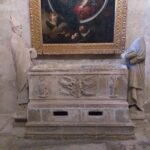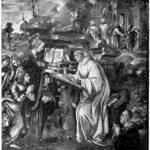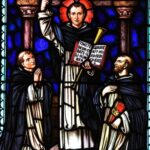St. Simon the Zealot
St. Simon the Zealot
When they lived: St. Simon the Zealot is believed to have lived during the 1st century AD.
Where they lived: Simon’s origins are somewhat shrouded in mystery, but he is often associated with the region of Cana in Galilee, hence his alternate name “Simon the Canaanite.”
Notable world events during the time of their life:
- The Roman Empire: During Simon’s lifetime, the Roman Empire was at its zenith, influencing the political and cultural landscape.
- The Life of Jesus Christ: Simon’s calling by Jesus marked the beginning of his journey as one of Christ’s apostles.
- The Jewish-Roman Wars: The 1st century witnessed conflicts like the Great Jewish Revolt and the destruction of the Second Temple in Jerusalem.
- Scientific Progress: While not widely documented in relation to Simon, this era saw advancements in fields like astronomy and medicine.
- Cultural Diversity: Galilee, where Simon is associated, was a melting pot of cultures, contributing to the diversity of ideas and beliefs.
- Trade and Commerce: The 1st century saw flourishing trade along the Silk Road and the Mediterranean, shaping the world in which Simon lived.
Their patronage: St. Simon the Zealot is often considered the patron saint of curriers and tanners, symbolizing personal transformation and the enduring impact of faith.
Chosen to be Christ’s Apostles
After spending a whole night in prayer, the Lord Jesus Christ chose twelve men who were called Apostles. He chose rather unlikely candidates (Jesus could have chosen the best and the wisest!) who would be His Apostles and to proclaim the Kingdom of God to all peoples. Most of us knew the “more popular” Apostles like Peter, John, Matthew, Thomas and even Judas Iscariot. If there are more known Apostles, then there are also least known Apostles. Two of these are Sts. Simon and Jude.
Simon and Jude were ordinary men who were chosen by Jesus Himself to proclaim the Good News and to “make disciples of all nations” (Matthew 28:19). Their names appear in the list of Apostles in Matthew 10:2-4, Mark 3:16-19, Luke 6:14-16 and Acts 1:13. Simon and Jude, unlike the other Apostles, had little “exposures” in the Gospels, which makes it quite difficult to know some details of their life.
Closest to Jesus
However, with their almost incognito identity in the Gospels, it is ironic that these two were actually among the closest to Jesus. Both Simon and Jude were cousins of Jesus! Tradition is quite sure of it as regards Jude Thaddaeus, since Cleopas, his father, was the brother of Joseph, the foster father of Jesus. His mother, Mary of Cleopas, was a cousin of the Virgin Mary. As for Simon, things are shrouded in mystery. Many identify in Simon the homonymous cousin of Christ, brother of James the Lesser.
Called by Other Names
Simon and Jude were known by other names during their lives. Simon was called “the Zealot” or “Zelotes”. The Zealots were a violent political party of strict adherence to the Torah and were concerned for the national and religious life of the Jews, which unfortunately led them to despise even their fellow Jews who sought conciliation and peace with the Roman authorities. As a member of the Zealot party, Simon believed in the importance of people adhering to Jewish law. However, his encounter with Jesus changed his life. He became convinced that the most important thing was to follow Jesus and his teachings. Moreover, another reason Simon had a nickname was to keep people from confusing him with the other Simon, who was called Peter by Jesus.
On the other hand, Matthew and Mark call Jude simply “Thaddaeus” (Matthew 10: 3; Mark 3: 18), while Luke calls him “Judas, the son of James” (Luke 6: 16; Acts 1: 13). Jude was named Jude Thaddaeus or Judas Thaddaeus. Just like the reason for avoiding confusion, this title was used to distinguish him from the other Apostle Judas who betrayed Jesus. The only recorded statement of Jude Thaddaeus was during the Last Supper Discourses of Jesus, when he asked “Master, [then] what happened that you will reveal yourself to us and not to the world?” (John 14:22).
Partners in Mission
After the Pentecost, the Apostles dispersed from Jerusalem to proclaim the Gospel in other places. Jude Thaddaeus departed from Galilee and Samaria and went to Syria, Armenia and Persia. Authoritative sources claim that in this area, he met Simon and became partners in the mission. Because of their eyewitness accounts of the life and ministry of Jesus, their missionary activity won many converts.
Their proclamation won many believers, as well as enemies. They were arrested and taken to the Temple of the Sun. There, they were made to renounce Christ by worshipping the goddess Diana. Jude Thaddaeus, in refusing to deny Christ, declared that idols were false gods. It was said that two demons came out of the temple and destroyed him. Overwhelmed by fright, the people who witnessed this are said to have pounced viciously on the two Apostles and were brutally killed. These holy men have their feast day on October 28.
Five Interesting Facts About St. Simon the Zealot and Jude Thaddaeus
- St. Jude Thaddaeus is the patron saint of desperate cases and lost causes.
- St. Simon the Zealot is the patron saint of couriers, tanners, woodcutters and sawyers.
- The nickname “Thaddaeus” is of uncertain origin and is explained either as coming from the Aramaic, taddà’, which means “breast” and would therefore suggest “magnanimous”.
- The Gospels according to Matthew and Mark describe St. Simon as a “Cananaean”.
- According to the apocryphal Acts of Simon and Judas, St. Simon was martyred by being cut in half with a saw.
Prayer to St. Simon the Zealot
O God, who by the blessed Apostleshave brought us to acknowledge your name,graciously grant,through the intercession of Saint Simon,that the Church may constantly growby increase of the peoples who believe in you.Through our Lord Jesus Christ, your Son,who lives and reigns with you in the unity of the Holy Spirit,one God, for ever and ever. Amen.



